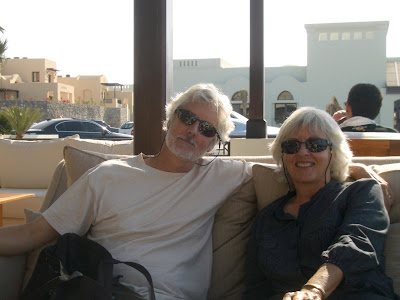At Nawalgarh we could have chosen to stay in the pristine and secluded Apu Dhani, an organic farm with accommodation in traditional thatched huts,

but we prefer to be right in town and have chosen instead the Ramesh Jangid Tourist Pension also owned by the family who run the farm. It doesn't look very prepossessing from the road,

but there are great views from the roof, both into the streets below,

and more distant as Michael's sketches on his
website show.
Furthermore, our room is delightful - spacious, airy, and beautifully decorated with murals done by local artisans. The artisans are more often employed in restoration work (see below) but from time to time, when money is available, are invited to embellish these blank walls with work of their own design.


Ramesh Jangid's son, Rajesh, and his family who run the pension are charming, helpful, and, with his father, dedicated to preserving the historic mansions of their region, Shekhawati, which once lay in the path of the old Silk Road. With the coming of the railway and roads that bypassed Nawalgarh for more direct routes, rich merchants who had built their lavish havelis along its winding streets moved away to Calcutta or Mumbai, leaving their homes with caretakers or simply abandoned. In recent years, the walls of many of the havelis have been defaced by posters and graffiti, or broken up to accommodate shopfronts. Weather has also been an enemy of the gilding and natural dyes, which are fading and flaking under the onslaught of sun and rain.



Yet it is still possible to wander the streets and deserted courtyards, and marvel at the skill of artists who decorated every surface with flowers, birds, animals, religious figures and local life, including some Edwardian English figures, cars and locomotives.




It is these murals that the Jangid family are trying to preserve before it is too late. They have a website, which records their projects and progress:
Friends of Shekhawati.
Progress has been slow. If more tourists come to stay in this area, rather than drive through with the windows rolled up and the air-conditioning running, as many now do, the money they bring with them may save the town. Alternatively, perhaps they just need one sympathetic and wealthy investor.
By contrast with the melancholy and deserted havelis, the narrow streets in the centre of town are crowded with cows, shoppers,

and rickety stalls with makeshift awnings.

In one corner, where the remains of the old fort are barely visible above a thriving fruit and vegetable market...

...we climb a narrow staircase, pass through a room where three schoolchildren are curled up on a bed doing their homework, and on payment of a few rupees are shown into the Sheesh Mahal, a windowless circular room that is all that left of the former palace. Thanks to the darkness in which it is normally languishing, the remarkable frescoes on its walls and celing have retained much more of their colour than the ones we have seen in the surrounding mansions. Unlike other frescoes we have seen, these ones depict with considerable accuracy street maps of Nawalgarh...

and of old Jaipur,

as well as some lovely scenes of horses, camels and elephants marching into battle,

and a doe-eyed maiden with a doe.

When we emerge into the bright sunlight, we encounter a small procession blocking one of the main arteries into town.

On both sides of it a jam of gaily-decorated autorickshaws, bikes, motorbikes, and donkey carts waits patiently to get on their way. Once through the bottleneck, it's back to noisy horns, exhausts belching black smoke, grinding gears. Only the tiny donkeys with their impossible loads are quiet, clip-clopping daintily over the ruts and potholes.

Halfway back to the peace and seclusion of our room, we seek temporary respite in a park of well-clipped hedges, children's playgrounds, a statue of Gandhi, and a magnificent white bougainvillea.





























































